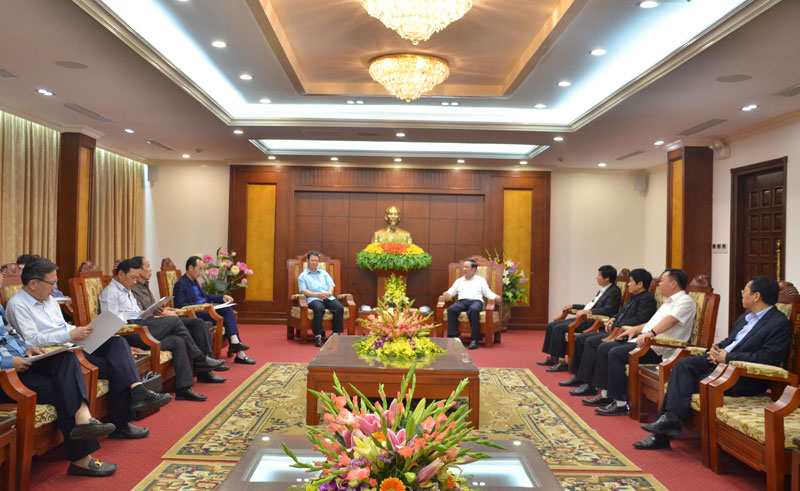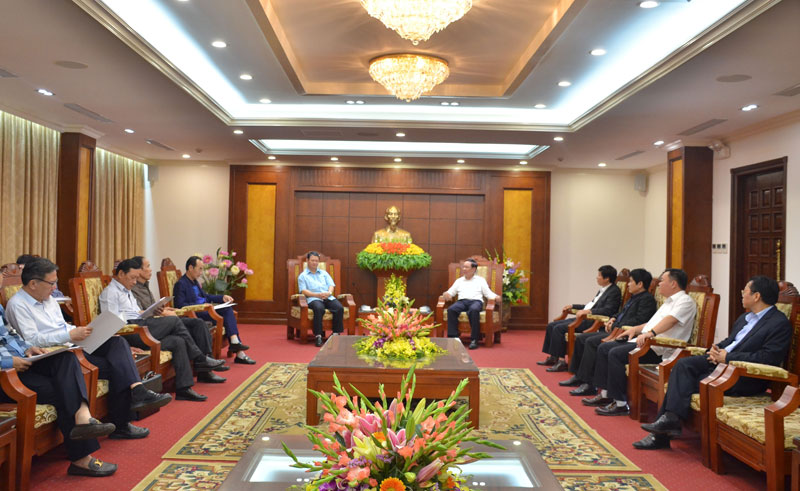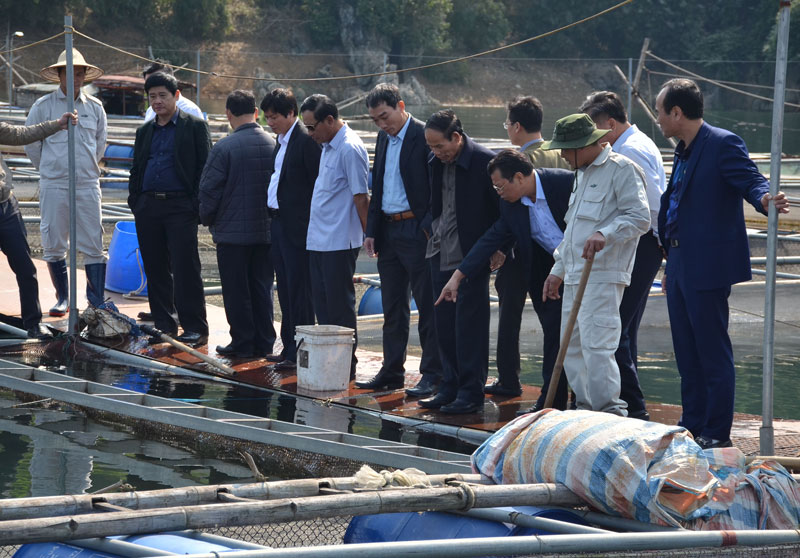
(HBO) – A delegation from Lao Cai province, led by Secretary of the provincial Party Committee and Chairman of the provincial People’s Council Nguyen Van Vinh, paid a working visit to Hoa Binh province on March 9.
The
delegation was welcomed by Secretary of the Hoa Binh Party Committee Bui Van
Tinh, Deputy Secretary of the provincial Party Committee and Chairman of the
provincial People’s Council Tran Dang Ninh, and Vice Chairman of the provincial
People’s Committee Nguyen Van Dung.

Secretary of provincial Party Committee
Bui Van Tinh and local leaders receive the Lao Cai delegation.
Outstanding achievements in socio-economic development of Hoa Binh province
were highlighted at the meeting. Tinh introduced the guests of the province’s typical
economic models and arrangement to streamline local organisation in line with
the spirit of the Resolution 39-NQ/TW.
Hoa Binh province is developing citrus fruit areas in Cao Phong, Kim Boi, Tan
Lac and Lac Thuy districts. Currently, the province is home to 8,600 hectares
of citrus trees, 3,700 hectares of which are set aside for business purpose,
Tinh underlined, adding that the locality has worked to branch out caged fish
breeding on Da River with more than 7,700 tonnes of fish raised in over 4,000
floating cages.
The province has 51 new style rural areas, eight industrial parks housing 442
projects including 30 FDI projects and 2,318 enterprises, he said, noticing
that the province has grasped investors’ interest in tourism and golf course
construction.
Nguyen Van Vinh, for his part, spotlighted Lao Cai’s strengths like local
tourism attracting over 3.5 million tourists and value of imports and exports
reaching over 2.58 billion USD in 2017. The province has over 4,000 busineses
with total registered capital of 60 trillion VND.
Under the Politburo’s Resolution 39-NQ/TW, the province streamlined and
rearranged local apparatus personnel, saving some 70 billion VND in 2017.
Lao Cai province’s working group visited outstanding economic models in Hoa
Binh like orange plantation in Cao Phong district, caged fish breeding on Hoa
Binh lake, Luong Son industrial zone and Hoa Binh hydropower plant.
Leaders from both sides discussed measures to promote cooperation opportunities
between the two localities.
Tran Dang Ninh, Deputy Secretary of the
Hoa Binh Party Committee and Chairman of the provincial People’s Council, and the
Lao Cai delegation group visit the caged fish breeding model on Da River.
Hoa Binh province is undergoing a dynamic transformation amid Vietnam’s national digital transition. Building on Poliburo’s Resolution No. 57-NQ/TW on breakthroughs in science, technology, innovation, and national digital transformation, the province has rolled out a wide range of practical action plans. A standout initiative is the "Digital Literacy for All” movement, an effort to ensure that no one is left behind in the digital era.
Hoa Binh province is undergoing a dynamic transformation in the wake of the national digital transformation movement. Building on Resolution No. 57-NQ/TW of the Politburo on breakthroughs in science, technology, innovation, and national digital transformation, the province has implemented a wide range of practical action plans. A standout initiative is the "Digital Literacy for All” movement ambitious effort to ensure that no one is left behind in the digital age.
With a spirit of unity and proactive problem-solving, the Party Committee, the government and the people of Dong Lai Commune (Tan Lac District) have made great strides in implementing the resolutions of the 24th Party Congress of the commune for the 2020 - 2025 term. Focusing on leadership and practical actions, the commune has brought the Party’s resolutions into daily life, creating strong impacts and pushing the local development forward.
Amid the nationwide push for digital transformation, young people in Hoa Binh Province are stepping up as dynamic pioneers, applying technology to enhance Youth Union operations and expand the reach of youth-led initiatives. Through creativity and adaptability, Youth Union organizations at all levels have introduced a series of practical solutions, contributing to modern governance and community development.
In recent years, An Nghia commune, located in Lac Son district, has stepped up administrative reform, focusing on improving the quality and efficiency of its single-window service unit for receiving and processing administrative procedures. These improvements have helped create favourable conditions for local residents and organisations to handle administrative procedures, contributing to the commune’s broader socio-economic development.
The Prime Minister-approved master plan to develop the multi-use value of forests ecosystems through 2030, with a vision to 2050, aims to improve the management and sustainable use of forest resources, create jobs, increase incomes, and improve the living standards of ethnic minorities, people in mountainous and remote areas, forest workers and those living near forests.




